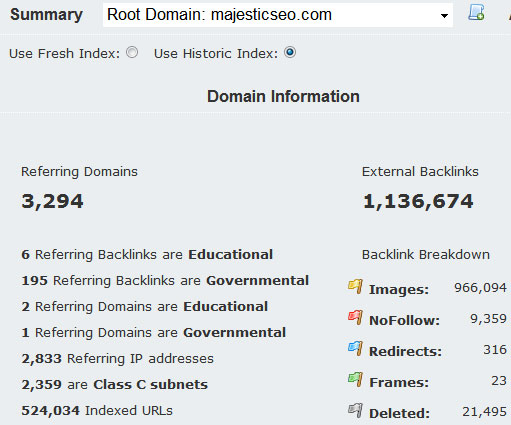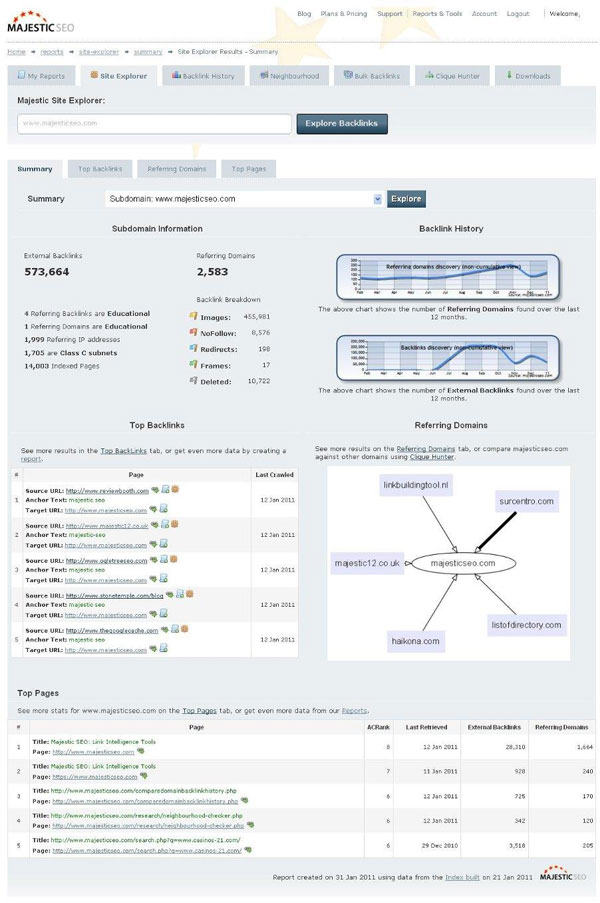Let’s talk about Backlinks: Interview with Dixon Jones
![]() This is an interview with Dixon Jones. Dixon is the Marketing Director of MajesticSEO and a founding Director of Receptional, a leading UK Internet Marketing Consultancy. Dixon has been involved in running businesses since 1988 and has been involved in running and marketing online businesses since 1997. Follow Dixon on Twitter
This is an interview with Dixon Jones. Dixon is the Marketing Director of MajesticSEO and a founding Director of Receptional, a leading UK Internet Marketing Consultancy. Dixon has been involved in running businesses since 1988 and has been involved in running and marketing online businesses since 1997. Follow Dixon on Twitter

Today we have with us Dixon Jones. Dixon is the Marketing Director at MajesticSEO and the Founding Director of Receptional LTD. Dixon thank you very much for accepting our invitation.
First of all I would like to ask you few questions concerning the MajesticSEO Site Explorer and the new innovative features that you have recently released. Moreover I would like to know which of your metrics you consider more important and how much correlated they are with high rankings. Finally I would like to get your thoughts concerning the future of SEO and discuss whether you consider the PageRank and the Backlinks still important signals for Search Engines.
1. MajesticSEO is one of the largest Link Analytics providers of the world and it has built over the years a very large index with more than 340 billion pages. How difficult was it to gather and analyze all these pages? How challenging is it to keep the index up-to-date?
Well – it is certainly challenging, but we are very fortunate to have an extremely loyal community around the world helping us to collect this data. This gives us the ability to scale our crawl to the same level as the major search engines – possibly even faster. A few days ago we crawled over 800,000,000 URLs in a single day. Analyzing all this data is a whole different ball game though. Here’s a picture of one of the machines we use to do this: teraflopweb. This is equivalent to between 300 and 600 PCs in a single unit. This particular machine works on our bigger – historical index. We have quite and air-conditioning overhead! I am not the architect of all this wizardry – but I have to say almost all of the database coding was written from the ground up, as the database is so large. The greater and more recent challenge was to be able to analyze the fresh data daily. We are really proud of this and we know that this is not something that can be replicated by your average office coding expert – it needs a real understanding of scale issues.
2. Due to your large index you were able all these years to have a clear view of the way that websites link to each other. Have you spotted any trends about the way that people link to other pages or websites? How did the social media affect the link graph?
One thing that I am seeing is a strong correlation not with Total Links and Search traffic, but with the LINK DISCOVERY RATE and overall traffic. When you compare our link discovery charts with sites that track traffic values – like Alexa or Compete – I see correlations there. Not in all cases, of course, but if a link discovery rate profile suddenly jumps and the traffic doesn’t follow – then I get suspicious. What is happening, I think, is that when links get onto the home pages of blogs or in social media links, they temporarily generate interest, clicks and sometimes search rankings, but as those blog posts get buried by newer posts and the social media “moment” passes, the traffic and rankings fall back. Site that can create links that are on pages which maintain a strong link structure and relevance over time get the long term effect.
3. Matt Cutts has mentioned in the past that nofollowed links are only a small percentage of links on the Web. Do you agree?
On the whole, yes. However it is highly dependent on the way in which a site or brand promotes itself. If you spend a lot of time commenting on blogs and using social media, then I have seen sites with 25% of their links marked as nofollow. Then other sites have as little as 1%. Majestic SEO is in the 1% category (See the picture) but in our case, around 10% of all links are in images – probably because of the backlink history too.

4. MajesticSEO has recently launched a brand new version of the Site Explorer. Both the design and several functionalities of the panel have changed. What are the most important updates that you made and which are the key new features that users must use?
There are two REALLY important changes. The first is that we now show you backlinks right in the Site Explorer interface. Before we told you how many links went to each of the pages on your site, but you had to get a full report to see the links themselves. Now (as long as you have a silver subscription of higher) we show the main links right on the dashboard. 2500 of them or more in higher subscription levels. The second change is newer, in that you now have the choice of selecting results from out Fresh Index or our Historic Index. The size of each index is listed on the homepage of Majestic SEO. The most important links should be in both indexes, but the fresh index will contain new links and the historic index includes links that we were not able to crawl again in the last 30 days – including historical information about link campaigns and link that have gone by the way and deleted over time.
5. How can SEO Professionals and Webmasters benefit from your Backlink Analysis Reports? How can they improve the way that they do Backlink Analysis and Link Building?
I think what we do is lay it all out bare – for all to see. Trying to spot paid link campaigns or artificial strategies has now become incredibly easy with the arrival of Majestic SEO. What is a real challenge for the SEO, though, is to decide which links are “doing the business”. I think every SEO needs to come up with their own definition of what constitutes a “GOOD” link. We do not plan to be advisors as much as we are data providers. The stronger you get at SEO, the more you find value in the Majestic SEO data. But ultimately, the data can show you:
- Where your competitors are generating their traffic from – be it links affecting rankings or direct traffic
- Hubs of authority in your verticle – using our Clique Hunter tool
- The ability to spot new links and trends daily now that we have the Fresh Index (which will have a huge impact on social media monitoring)
- The ability to rapidly analyze anchor text
- The ability to analyze links at the URL level (rather than just at the domain level).
Of course, the main and ultimate use of this is to generate links to your site which will improve your standing in the search engines- but there are other uses. Because we can filter links by URL structure as well as anchor text, for example, campaign URLs and often affiliate URLs are also exposed, showing you more than JUST a competitor’s search optimization strategy.

6. What are the plans of MajesticSEO for the future? Which parts would you like to improve on the next months? Can you give us a hint about the upcoming features of your service?
I get shot by Alex the founder for telling that sort of thing. However – I absolutely promise that we are not resting on our laurels. We are testing out a couple of things which – if our tests prove successful – will improve our offering another notch. But the thing about tests is that until you finish them, you don’t know the findings! For my part, we have been working hard on Video tutorials, to help users get to grips with the things we already have.
7. Majestic SEO has several interesting metrics such as the total number of links, the ACRank, the .EDU/.GOV links, the total number of linking domains, the total linking IP addresses or C Classes etc. Which of these metrics give a clearer picture about the quality of a link/page?
AC Rank is effectively a logarithmic interpretation of the IP addresses and I think that this is most helpful – however – ACRank does not filter out spam networks/content farms and this is something that we would like to address. Spam aside, though, ACRank is not a bad indicator of quality.
8. In the past you have published a report on how to predict PageRank by using one of your metrics. Have you ever studied the connection between your link metrics and the probability of achieving high results on search engines? Which of your metrics can be considered as the best predictor?
Well unfortunately – whilst that post helped to predict Page Rank, Page Rank is no necessarily a good predictor of rankings! I have studied correlations between rankings and metrics, but it is a confusing picture at the best of times, because I feel that Google uses different algorithms within the top ten results. This is quite clever by Google, as it helps to give users a slightly more diverse set of results – but trying to beat the site above you by doing more of the same that got you to where you are may not work. You do not need to look too far to see evidence of this. Image results and other Universal results get embedded into the main SERPs at apparently inconsistent intervals. It is not beyond the wit of Google to similarly apply the algo differently to different parts of the SERPs.

9. Several SEO professionals believe that PageRank is no longer important in SEO. Some of them even suggest that links are becoming less and less important. Do you agree with them?
There are several concepts around what Page Rank is. The little green bar that Google shows is the only public facing one and it is static for long periods and updated infrequently. Internally, I still believe that Google uses the concept of PageRank but there are so many other competing signals that I would not get overly hung up on Page Rank as a metric. You should consider this… whenever a new page is created on the Internet, it starts with Page Rank ZERO. It has no links and no history. But it does not take long for Google to notice!
10. Where do you see SEO and Search Engine Marketing on the near future?
As long as Google has organic traffic, it will be here. The more Google tries to obfuscate the results, the more people will try to manipulate them. However – I do believe Google is now trying to tackle their SERPs quality issues and if they do this right, they will encourage strategies which are more akin to helping the web that hindering the web. I think in the near future, SEO will move much more towards social strategies and in the process will care a little less about Google and a little more about Facebook.
Dixon thanks a lot for this interesting inteview.
Do you have questions for Dixon? Leave your comment below.

 13 Comments
13 Comments


